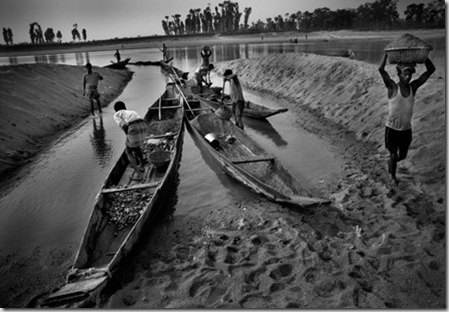Uomini e pietre in Bangladesh
The Bangladeshi photographer Khaled Hasan's impressive B/W reportage about stone-breakers in Bangladesh for which he was awarded with the Mark Grosset Price in 2009 alongside Christian Burkert (for »Last Exit Detroit«), a photography graduand from the University of Applied Sciences and Arts Hannover.
Living Stone: A community losing Its Life.
A Photo Documentary by Khaled Hasan.
“Once upon a time there was a blue River that flowed in Jaflong, but now it is going to lose its natural beauty. Uncontrolled stone-crushing threatens the local people’s health.” – Probal Das, a stone worker. The story which I emphasis on is about a hard work community of Jaflong, which is located on the north eastern part of Bangladesh. The Piyain River is the main feature and natural beauty of Jaflong which flows from India through Bangladesh. During the monsoon, the river currents wash down precious rocks and pebbles from India into Jaflong area. At dawn every day, more than a hundred little boats with laborers enter the Piyain River, buckets and spades in hand. This is one trade which has a geological limit. The stones that tumble down the riverbed from India are decreasing in volume and the laborers are already taking the risk of invading the no-man’s land along the Indo-Bangla border which is a contradictory political issue between Bangladesh and India. Many laborers were killed by BSF in that Borders Area. More than 5,000 men, women and child stone-laborers are engaged here. Uncontrolled and unstoppable stone extracting and crushing at Jaflong has been posing a serious threat to public health, and to the environment and agriculture in the area. There is no legal protection and no human rights in this Stone Industry. Many children there have been suffering from hearing problems due to the high-pitched sounds of the stone-crushing machines.
During my working from 2006 as many as 250 machines are engaged in crushing stone at Jaflong. Abul Hossain, a local, told me they cannot produce crops on their lands as dusts of crushed stones destroy all their efforts in this regard.
The Bangladeshi government has failed to take any initiative to prevent the stone-crushing industry at Jaflong and the resulting high rate of erosion which is threatening to destroy the adjacent Khasia (indigenous people) villages within the next 5 years. I realize their hassles, I saw their hard work and I saw their happy moments also. So, I want to visualize the facts of this suffering society and their personal feeling through my way in a little space.

1-This industry is harmful to the environment; it is harmful for the health of workers, creates air pollution, sound pollution, and is destructive to the landscape, amongst other things. This broken stone represents the dire situation.

2-Alfaj Hossain is a stone collector living in Banglabazar, two and a half kilometers from Jaflong. He either walks or takes a boat ride from his home to work. Everyday he collects three boat fulls of stones and earn 150 taka ($ 2.17) per boat.

3-Uses of modern machinery like cranes have caused stones to become extinct in some places in Piyain. For this reason the stone collectors have to work hard. Every night with their boats they travel upstream to collect stones and dock it on the banks ready for supply.
![clip_image001[6] clip_image001[6]](https://blogger.googleusercontent.com/img/b/R29vZ2xl/AVvXsEjytL-iJqYAnhwTxSrj6dlWm3bSEuHYikFFHnUxI3ldThDoI0MCcG0Q8OHhq2jukZ4ncNbvoWAwaiT4ZJsWWfV_9qoInGCxPGn1kBmZv7CLgg7t0EIAuoHnORo-a2bD9NCrjgc3mKPjU4Q/?imgmax=800)
4-Probad Das (age 67) and Priti Rani Das (age 39) are a couple working together as stone laborers. They are working here for four years. They have two daughters. They used to earn 400 taka ($ 5.79) per day before. But now each of them earns 150 taka ($ 2.17) per day. Some day they only get 80 taka ($ 1.15) for their

5-Babul (age 32), Faruk (age 35), Manik (age 29) and Joinal (age 31) are loading a truck with broken down stone chips. These are transported to the city, to be used at multistoried construction sites. They are also used for building roads and highways in different areas of Bangladesh.
![clip_image001[10] clip_image001[10]](https://blogger.googleusercontent.com/img/b/R29vZ2xl/AVvXsEjS6crqvGwyCqTZaYWmYs_2YeB2qcHX1JX-cDDbae8I9t_q6A7nadWiPsbaSoPkfdKde7cToZSMgVh7HfxCoLLNEFL7WdISzpUh6s0_fFbChurQtge8qHBtgmcczLSwl5ssXwiql6sOAzHF/?imgmax=800)
6-Kalam Ali (age 26) has been working at a stone crushing machine for last four years. He knows there are many risks in stone crushing. He covers his face using his Gamchha (local weaved cloth), as an attempted safety measure from breathing in dust particles.

7-Stone collector Abu Bakkar bathing at the bank of the Piyain River after finishing his work.
![clip_image001[16] clip_image001[16]](http://lh4.ggpht.com/_vflyDMbzgcU/TAuFn079XhI/AAAAAAAAQaI/8esJ64T2ibQ/clip_image00116_thumb%5B3%5D.jpg?imgmax=800)
8-Shapna (age 13) works as a stone collector. Sometime she does not work because of her childish pranks. She is not old enough for the work. Between working hours, she travels by her
![clip_image001[14] clip_image001[14]](https://blogger.googleusercontent.com/img/b/R29vZ2xl/AVvXsEhELmBszpxlReL95p5ZKqu7Hc2u5HzSZTS5RUgu8NO6jRzTZ3UFciEuJ9TPx46JezcRM6LAlMV0TSltyln3XxifF-e9_xLvEf3RJ_cVr7Q-saFEhmsisrQxZp3863z2QvCBRSjZLt1ZDsU/?imgmax=800)
9-Rajiv Das (age 42) is working at stone crusher machine. His job is to remove the byproduct of stone dust. He realizes that this work is hazardous, as one breathes the dust while working here. Many workers like Rajib Das doing the same duty.
![clip_image002[4] clip_image002[4]](https://blogger.googleusercontent.com/img/b/R29vZ2xl/AVvXsEgPob4PvNP_sbk9-iNs3v9M1PbrIWLqkgG1hN0WyCq8O93etJRV5CBGV6GcuVDybij3OuRTKlMZQ8IxRcmFATZCtgdfRref93no-oYL9T08ToTE0F9wFsGWbL2ss7Rli3HTfIiBvBbBkOdC/?imgmax=800)
10-Many children are utilized in collecting stones. This boy is collecting stones and a bucket of stone chips which will pay him 5 taka ($ 0.071) at the end of the day.
Khaled Hasan © All rights reserved
Fonte

Nessun commento:
Posta un commento